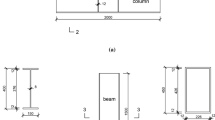Abstract
A large number of steel moment frames fractured at the welds of beam-to-column connections in earthquake. As the weld damage behavior is a crucial factor for aseismic performance of steel frame connections, 20 local welded connections representing beam-to-column connections were tested under monotonic and cyclic loads to study the weld damage behavior in this paper. The failure modes and deformation curves were recorded; the effects of material strength, load types, and beam geometries on the connection damage behavior were analyzed. Three damage evolution models were calibrated, the relation between weld damage and macro connection performance was established. The results indicate weld cracking and plate buckling are the main causes of the connection damage; the range of cyclic loads is the key factor affecting the weld damage level; the plastic strain based damage model illustrate the damage process with good accuracy. This study provide technical basis for the damage evaluation and fracture prevention of the welded steel beam-to-column connections.
Similar content being viewed by others
References
Beremin F.M. (1983). “A local criterion for cleavage fracture of a nuclear pressure vessel steel.” Metall. Trans. Vol. 11, pp. 2277–2287.
Binnur G.K. and Secil E. (2005). “Prediction of fracture behavior of steel beam-to-column connections with weld defect using the SINTAP.” Engineering Structures, Vol. 27, pp. 760–768.
Chi W. M., Deierlein G. G., and Ingraffea A. (2000). “Fracture toughness demands in welded beam-column moment connections.” Journal of Structural Engineering, ASCE, Vol. 126, No.1, pp. 88–97.
Cosenza E. and Manfredi G. (1992). “Seismic Analysis of Degrading Models by means of Damage Functions Concept.” Nonlinear Seismic Analysis and Design of Reinforced Concrete Buildings, Elsevier.
GB/T5117-1995 (2011). Carbon steel covered electrode, China Standards Press.
GB50661-2011 (2011). Code for welding of steel structures, China building industry press.
GB-T1591-1994 (1994). High strength low alloy structural steels, China Standards Press.
Han Lin Hai. (2004). “The concrete filled-steel tube structure: theory and practice.” Beijing: Science Press.
John W. F., Robert J. D., and Eric J. K. (1995). “Fracture Mechanics of Welded Structural Steel Connections.” SAC report No. 95-09, Washington, DC.
Kato B. and Akiyama H. (1975). “Aseismic Limit Design of Steel Rigid Frames.” Proceeding of Architectural Institute of Japan, No.237, Nov., 1975.
Kaufmann E.J. and Fisher J.W. (1995). “A study of the effects of material and welding factors on moment frame weld joint performance using a small scale tension specimen.” Technical report SAC 95-08.
Kravinkler H. and Zhorei M. (1983). “Cumulative Damge in Steel Structures Subjected to Earthquake Ground Motions.” Computers and Structures, Vol. 16, pp. 1–4.
Krawinkler H. and Nassar A. A. (1992). “Seismic Design based on Ductility and Cumulative Damage Demands and Capacities.” Nonlinear Seismic Analysis and Design of Reinforced Concrete Buildings, Elsevier.
Kumar S. and Usami T. (1994). “A note on evaluation of damage in steel structures under cyclic loading.” Journal of Structure Engineering”, JSCE, Vol. 40A, pp. 177–178.
Liu Y.M., Chen Y.Y. and Chen Y.J. (2002). “Hysterical Model of Steel Frame Connection Considering Partial Fracture.” Journal of Tongji University (Natural Science), Vol. 31, No. 5, pp. 525–539.
Matos C.G. and Dodds R.H. (2001). “Probabilistic modeling of weld fracture in steel frame connections part I: quasistatic loading.” Engineering Structures, Vol. 23, pp. 1011–1030.
Matos C.G. and Dodds R.H. (2002). “Probabilistic modeling of weld fracture in steel frame connections part II: seismic loading.” Engineering Structures, Vol. 24, pp. 687–705.
Park A. J. and Ang H. S. (1985). “Mechanistic Seismic Damage Model for Reinforced Concrete.” Journal of Structure Engineering, Vol.111, No.4, pp. 195–207.
Powell G. H. and Allchabadi R. (1988). “Seismic damage prediction by deterministic methods: Concept and procedures.” Earthquake Engineering and Structural Dynamics, Vol. 16, pp. 719–734.
SAC. (1995). “Interim Guidelines: Evaluation, Repair, Modification and Design of Welded Steel Moment Frame Structures.” SAC-95-02, Sacramento, California.
Shen Z.Y. and Shen S. (2002). “Seismic Analysis of Tall Steel Structures with Damage Cumulation and Fracture Effects.” Journal of Tongji University (Natural Science), Vol. 30, No. 4, pp. 393–398.
Tawil S., Mikesell T., Vidarsson E. and Kunnath S.K. (1998). “Strength and Ductility of FR Welded-Bolted Connections.” SAC report No. 98-01, Washington, DC.
Shi W.L, Xiao Y., Li G.Q. and Ye Z.M. (2008). “Pseudodynamic tests on composite joints with flush end plate connections.” Earthquake Engineering and Engineering Vibration, Vol. 28, No. 6, pp. 124–133.
Shi Y.J., Ao X.L., Wang Y.Q. and Shi G. (2009). “Experimental study on the seismic performance of beam-to-column composite connections in medium-high strength steel frame structures.” China Civil Engineering Journal, Vol. 42, No. 4, pp. 48–54.
Su D. (2005). “Seismic Behavior of Beam-Column Connections in Steel Structure with Composite Effect.” Tsinghua University.
Toyoda M. (2002). “Properties of steel structures damaged in Hanshin-Japan and Northridge-USA earthquake.” Seminar notes. Dokuz Eylul University, Izmir(Turkey).
Yang T.S. and Popov E.P. (1995). “Experimental and Analytical Studies of Steel Connections and Energy Dissipators.” SAC report No. 95-13, Washington, DC.
Zhang L. (2004). “Study on earthquake resistance of rigid beam-to-column connection of steel structure.” Tianjin University.
Zhao D.W., Shi Y.J. and Chen H. (2000). “Experimental Research on Beam-column Connections Under Cyclic Loading.” Building Structure, Vol. 30, No. 9, pp. 3–6.
Author information
Authors and Affiliations
Corresponding author
Rights and permissions
About this article
Cite this article
Liu, X.Y., Wang, Y.Q., Xiong, J. et al. Investigation on the weld damage behavior of steel beam-to-column connection. Int J Steel Struct 17, 273–289 (2017). https://doi.org/10.1007/s13296-015-0070-8
Received:
Accepted:
Published:
Issue Date:
DOI: https://doi.org/10.1007/s13296-015-0070-8




